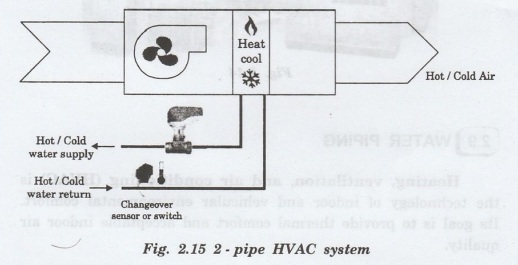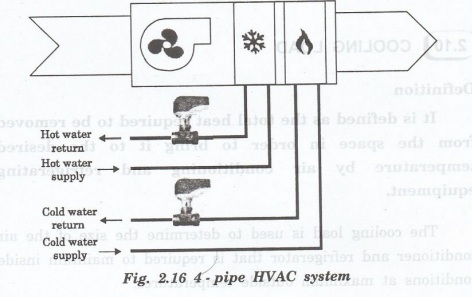Physics For Civil Engineering: Unit II: Ventilation And Refrigeration
Water Piping: Heating, ventilation, and air conditioning (HVAC)
Definition, Types, Working Principle, Construction, Advantages, Disadvantages
Heating, ventilation, and air conditioning (HVAC) is the technology of indoor and vehicular environmental comfort. Its goal is to provide thermal comfort and acceptable indoor air quality.
WATER PIPING
Heating, ventilation, and air
conditioning (HVAC)
is the technology of indoor and vehicular environmental comfort. Its goal is to
provide thermal comfort and acceptable indoor air quality.
In HVAC technology, water piping is one
of the important component which regulates the temperature. Generally there are
two types.
(i) 2-pipe HVAC system
(ii)
4-pipe HVAC system
2-pipe HVAC system
A 2-pipe HVAC system is one that uses
the same piping alternately for hot water heating and chilled water cooling.
4-pipe HVAC system
A
4-pipe systems have separate heating and
cooling fan coil units and separate pipes for heating and cooling. This means
that hot or chilled water is always available. So the system can immediately
change over from heating to cooling mode.
(i)
2-pipe HVAC system
The 2 pipe system consists of a single
water coil connected to two pipes (supply and return). This type of fan coil
cannot cool and heat at the same time and is dependent of the actual mode of
the building. (Fig. 2.15)

The 2 pipe fan coil requires a
changeover sensor, to determine the mode of the system.
These
units can be equipped with an auxilliary electric heater to compensate the
limitations of the system.
(ii)
4 - pipe HVAC system
The
4 pipe system consists of two separate cooling and heating water coils. Each
coil has its own set of pipes (supply and return) and valve. This type of fan
coil cool and heat at the same time and is not dependant of the actual mode of
the building. (Fig. 2.16)
Compared
to the 2 pipe system, the 4 pipe fan coil does not require a changeover sensor
since both hot and chill water is available.

These
units can be equipped d with an auxiliary electric heater to boost the
heating capacity (if required).
The 4 pipe fan coil can also use a chill
water coil and an electric or gas heater. As long as the cooling and heating
are independent t of each other, the system will be a 4 pipe lo sam odt ddiw
batsiooaas ai tser thotel olidw ser configuration.
Advantages
of 4- Pipe HVAC
1. Four-pipe systems have separate heating and cooling fan coil units and separate pipes for heating and cooling.
2.
The system can immediately change over from heating to cooling mode.
3.
Less time consuming to switch over.
4.
Four-pipe systems can cool some rooms while heating others.
Disadvantages
of 4- Pipe HVAC
They
are more expensive to install and maintain.
They are congestion due to the increased
piping.
Physics For Civil Engineering: Unit II: Ventilation And Refrigeration : Tag: : Definition, Types, Working Principle, Construction, Advantages, Disadvantages - Water Piping: Heating, ventilation, and air conditioning (HVAC)
Related Topics
Related Subjects
Physics for Civil Engineering
PH3201 2021 Regulation | 2nd Semester Civil Dept 2021 Regulation
